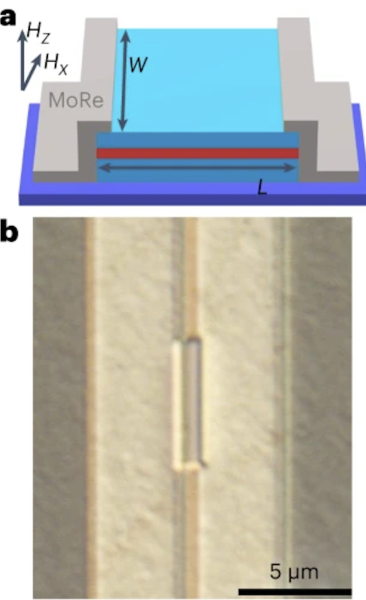Magnetically tunable supercurrent in dilute magnetic topological insulator-based Josephson junctions
Through a collaboration between theory and experiment by the Würzburg and San Sebastián groups, a proximity-induced Fulde–Ferrell–Larkin–Ovchinnikov (pFFLO) state was realized in (Hg,Mn)Te-based Josephson junctions. Using tunable Zeeman fields, the team identified clear signatures of pFFLO behavior via critical current re-entrance and 0–π transitions under accessible experimental conditions.
The Fulde–Ferrell–Larkin–Ovchinnikov (FFLO) state, theorized over half a century ago, describes a superconducting state with a spatially modulated order parameter emerging under a spin-splitting field. Historically elusive in experiments, especially under accessible conditions, the FFLO state and its proximity-induced counterpart (pFFLO) have drawn considerable recent interest. In this collaborative work between the theory group in Würzburg and the experimentalists in San Sebastián, a breakthrough was achieved in realizing and controlling the pFFLO state in Josephson junctions based on a two-dimensional dilute magnetic topological insulator, (Hg,Mn)Te.

Figure 1. Experimental setup.
The key to this success lies in the unique tunability of the Zeeman energy enabled by manganese doping in (Hg,Mn)Te. The experimental team exploited this feature to finely adjust the spin-splitting field using modest in-plane magnetic fields. As predicted by theoretical modeling from Würzburg, this setup creates ideal conditions for the emergence of a pFFLO state. The observed multiple re-entrant behaviors of the supercurrent—transitions from superconducting to normal and back again—as a function of magnetic field and temperature are clear hallmarks of transitions between 0 and π ground states in the junction. This behavior strongly indicates the presence of a spatially modulated superconducting state.
Unlike prior systems, where tuning the exchange field was either impossible or impractically destructive to the superconductivity, this platform allows for the observation of phase shifts and critical current re-entrance with unprecedented control. The synergy between theoretical predictions and targeted experiments was crucial for the interpretation.
This collaborative work not only confirms the existence of the pFFLO state under widely tunable and accessible conditions, but also opens the door to future studies on exotic superconducting states and novel quantum devices.

Figure 2. Comparison between experiment (a,b) and theory (c,d): Critical current vs temperature and magnetic field.



